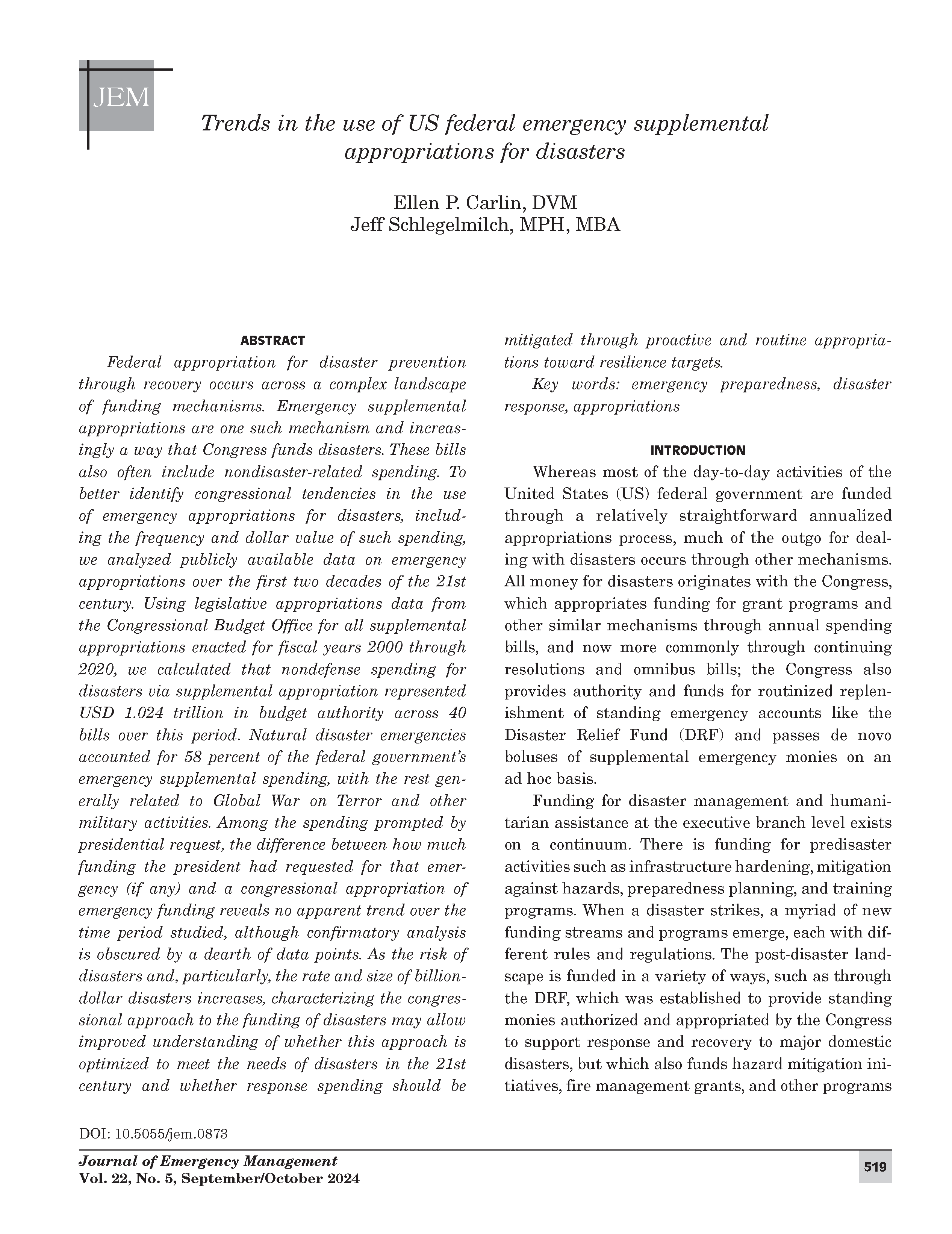Trends in the use of US federal emergency supplemental appropriations for disasters
DOI:
https://doi.org/10.5055/jem.0873Keywords:
emergency preparedness, disaster response, appropriationsAbstract
Federal appropriation for disaster prevention through recovery occurs across a complex landscape of funding mechanisms. Emergency supplemental appropriations are one such mechanism and increasingly a way that Congress funds disasters. These bills also often include nondisaster-related spending. To better identify congressional tendencies in the use of emergency appropriations for disasters, including the frequency and dollar value of such spending, we analyzed publicly available data on emergency appropriations over the first two decades of the 21st century. Using legislative appropriations data from the Congressional Budget Office for all supplemental appropriations enacted for fiscal years 2000 through 2020, we calculated that nondefense spending for disasters via supplemental appropriation represented USD 1.024 trillion in budget authority across 40 bills over this period. Natural disaster emergencies accounted for 58 percent of the federal government’s emergency supplemental spending, with the rest generally related to Global War on Terror and other military activities. Among the spending prompted by presidential request, the difference between how much funding the president had requested for that emergency (if any) and a congressional appropriation of emergency funding reveals no apparent trend over the time period studied, although confirmatory analysis is obscured by a dearth of data points. As the risk of disasters and, particularly, the rate and size of billion-dollar disasters increases, characterizing the congressional approach to the funding of disasters may allow improved understanding of whether this approach is optimized to meet the needs of disasters in the 21st century and whether response spending should be mitigated through proactive and routine appropriations toward resilience targets.
References
Federal Emergency Management Agency: FEMA grants. 2023. Available at https://www.fema.gov/grants. Accessed February 12, 2024.
Federal Emergency Management Agency: Disaster relief fund: Monthly reports. 2024. Available at https://www.fema.gov/about/reports-and-data/disaster-relief-fund-monthly-reports. Accessed February 13, 2024.
Smith JF: Budgeting for disasters: Part I. Overview of the problem. Public Manager. 2006; 35(1): 11-19.
Watson C, Watson M, Gastfriend D, et al.: Federal funding for health security in FY2019. Health Secur. 2018; 16(5): 281-303. DOI: 10.1089/hs.2018.0077. DOI: https://doi.org/10.1089/hs.2018.0077
Schlegelmilch J, Carlin E: Catastrophic Incentives: Why Our Approaches to Disasters Keep Falling Short. New York City: Columbia University Press, 2023. DOI: https://doi.org/10.7312/schl20422
Long B: Why will FEMA spend as much in past 2 years as the previous 37? Here’s how disaster aid works. The Hill. June 3, 2019. Available at https://thehill.com/opinion/energy-environment/446635-why-will-fema-spend-as-much-in-past-2-years-as-the-previous-37/. Accessed October 24, 2023.
Congressional Budget Office: CBO report: Supplemental appropriations enacted since fiscal year 2000. 2021. Available at https://web.archive.org/web/20220121082357/https://www.cbo.gov/system/files?file=2021-12/Supplemental-Appropriations-2021-12-09.pdf. Accessed October 24, 2023.
Painter WL: The Disaster Relief Fund: Overview and issues (Congressional Research Service report R45484). 2022. Available at https://crsreports.congress.gov/product/pdf/R/R45484. Accessed October 24, 2023.
NOAA National Centers for Environmental Information (NCEI): Billion-dollar weather and climate disasters. 2022. Available at https://www.ncei.noaa.gov/access/billions/. Accessed October 24, 2023.
Continuing Appropriations and Military Construction, Veterans Affairs, and Related Agencies Appropriations Act, 2017, and Zika Response and Preparedness Act, Pub. L. No. 114-223. 2016. Available at https://www.congress.gov/114/plaws/publ223/PLAW-114publ223.pdf. Accessed October 24, 2023.
Further Continuing and Security Assistance Appropriations Act, 2017, Pub. L. No. 114-254. 2016. Available at https://www.congress.gov/bill/114th-congress/house-bill/2028. Accessed October 24, 2023.
Lindsay BR: FEMA’s disaster relief fund: Overview and selected issues. 2014. Available at https://sgp.fas.org/crs/homesec/R43537.pdf. Accessed October 24, 2023.
Painter WL: Calculation and use of the disaster relief allowable adjustment (Congressional Research Service report IF10720). In Focus. 2023. Available at https://crsreports.congress.gov/product/pdf/IF/IF10720. Accessed October 24, 2023.
Katz R, Attal-Juncqua A, Fischer JE: Funding public health emergency preparedness in the United States. Am J Public Health. 2017; 107(S2): S148-S152. DOI: 10.2105/AJPH.2017.303956. DOI: https://doi.org/10.2105/AJPH.2017.303956
Department of Defense: Emergency supplemental appropriations to address hurricanes in the Gulf of Mexico, and Pandemic Influenza Act, 2006, Pub. L. No. 109-148. 2005. Available at https://www.congress.gov/109/plaws/publ148/PLAW-109publ148.pdf. Accessed October 24, 2023.
Smith AB: A historic year of US billion-dollar weather and climate disasters. Beyond the Data blog. 2023. Accessed at https://www.climate.gov/news-features/blogs/beyond-data/2023-historic-yearus-billion-dollar-weather-and-climate-disasters. Accessed February 13, 2024.

Published
How to Cite
Issue
Section
License
Copyright 2007-2025, Weston Medical Publishing, LLC and Journal of Emergency Management. All Rights Reserved.
Leave Nobody Behind: Emergency Management in a More Inclusive Way is a trademark of Journal of Emergency Management





